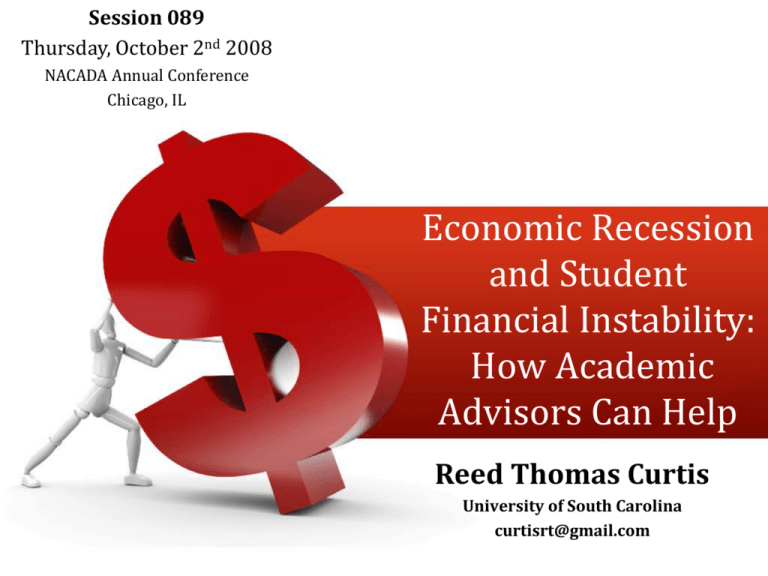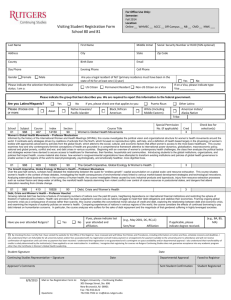PowerPoint Template - California State University, Long Beach
advertisement

Session 089 Thursday, October 2nd 2008 NACADA Annual Conference Chicago, IL Economic Recession and Student Financial Instability: How Academic Advisors Can Help Reed Thomas Curtis University of South Carolina curtisrt@gmail.com Presentation Overview “Blessed are the young for they shall inherit the national debt.” –Herbert Hoover 1 The Situation 2 The Students 3 The Support 4 The Strategies Conclusion Terminology • Recession: A significant decline in economic activity. In the U.S., recession is approximately defined as two successive quarters of falling GDP, as judged by NBER. A recession in one country may be caused by, or may itself cause, recession in another country with which it trades. (Deardoff, Alan V., 2008) • Financial Stability: The avoidance of financial crisis. (Deardoff, Alan V., 2008) Economic Crisis of 2008 • Housing Crisis—Subprime mortgages. • Meltdown of the top Wall Street investment banker Bear Stearns. • US Dollar at a record low compared to the Euro. • Oil Prices Skyrocketing – Leads to major aviation bankruptcies. • Global Inflation Crisis – Clothing – Food • Increased use of Food stamps, and governmental support. Economic Crisis of 2008 • • July 2008: – Mortgage leader Indymac is taken over by federal government. September 2008: – Lehman Brothers declare Bankruptcy—largest in US history. – Federal government bails out AIG and purchases 80% of stock. – Federal Government takes over mortgage giants Fannie Mae and Freddie Mac. – Washington Mutual is bought by JP Morgan Chase. – “Mother of All Bail-Outs (MOAB)”—Proposed $700 billion rescue package for troubled mortgage purchases. – Emergency Economic Stabilization Act of 2008 fails sending wall street on a nose dive, the DOW went down 777.88, the largest drop in US History for a single day. Rising Tuition and Fees “During the last decade tuition and fees alone at private and public universities grew by 40 percent and 33 percent, respectively. By comparison, the median family income increased by only 12 percent.” (Cappannari, 2002) 40% Private Universities 12% 33% Public Universities 1993-2003 Average Family Income Student Debt “Late night pizzas: $5,200. Books for class: $7,000. Tuition and Fees: $120,000. Moving back into your parent’s basement: Priceless” (Levine, 2004) College Student Population Level of Study Population Undergraduate 14,964,000 Graduate 2,186,000 First Professional 337,000 Total 17,487,000 (NCES, 2005) 64% Graduate with debt. (King and Bannon, 2002) Graduating Into Debt Percent of Students Graduating with Debt, by Type of Debt 64.00% 41.00% 12.00% Federal Student Loan Credit Card PLUS (King and Bannon, 2002) 6.00% Private Loan Debt Manageability 39% of Graduates with debt have loans that are Unmanageable. • Their student loan debt exceeds 8 percent of their pre-tax yearly income. Debt manageability is an even bigger problem for African-American and Hispanic students, who tend to come from lowerincome families and whose expected annual post-graduation income is below the national average. (King and Bannon, 2002) Debt Inequality (King and Bannon, 2002) Credit Cards College has become a “carnival atmosphere” where credit card companies view freshman and others as both "fresh meat” and potential long term customers (Johnson, 2005). Credit Cards • The majority of students obtain their first credit card in college, most in their first semester, and by graduation over half have multiple cards (Johnson, 2005). • Among the many reasons are heavy solicitation and credit card access, growing living and school expenses, lack of financial literacy etc (Johnson, 2005). Solicitation What is the average number of Credit Card offers a Freshman receives during their first week of classes? (Johnson, 2005) The Nightmare The Credit Card Nightmare – The Collection- efforts are often aggressive. – Stigmatization-embarrassed and lack supportive source of empathy. (scared to talk to parents) – The Burden- becomes constant and requires lifestyle changes. (Johnson, 2005) • Credit card and other debts can cause emotional problems and negatively impact their learning abilities in college. (Roberts and Johnson, 2001) • A student stressed over credit card debt may suffer “additional financial, psychological, and physical problems” (Norvilitis, 2003) (Johnson, 2005) Overwhelmed with Debt Ohio State University Research Challenge Program (Johnson, 2005) How do they pay? • Using Credit to Pay-off Credit – 60% of freshmen and 75% of upperclassmen have maxed out their credit cards at least once. – 60% of freshmen and 2/3rds of upperclassmen have used one credit card to pay off another one. – 73% of freshmen and 67% of upperclassmen used student loans to pay off credit card balances. (Chen and Volpe, 1998) • Bankruptcy – The Number of people under the age of twenty-six who filed for bankruptcy tripled between 1995-2000 (Johnson, 2005) Implications of Bad Credit •Employment Problems •Students with credit card debt-->work more, study less to repay debt and are not likely to have best grades-->hurts their ability to secure a wellpaying job upon graduation •Less than one third of freshmen in OSU Survey realized that they could be denied a job based on bad credit report. •Future life •American Dream: students with bad credit after graduation find a brutal inability to purchase a home at reasonable interest rate (Johnson, 2005) Tragic Responses • Financial instability can increase stress and lead to depression. • Some students feel so overwhelmed and hopeless that they commit suicide as a result. – The University of Central Oklahoma saw two specifically debt-related suicides within two years. (Johnson, 2005) The Academic Advisor’s Role • Increase personal financial literacy in order to empower students to do the same. • Keep up to date on financial issues that face students. – Academic success, health and well-being, and future quality of life. • Advocate institutional improvements and responses to the need for financial literacy amongst students. • Maintain an open-door policy as students in financial crisis feel they have no one to turn to. • Become a legitimate resource repository. (Curtis, 2008) Academic Advising •Encourage academic advising organizations on campus to offer professional development opportunities on the topic. •Be aware of all available services and direct students to them •Warn about the availability of biased and or false information on the internet. (Curtis, 2008) Higher Education Solutions •Financial Literacy: Universities must provide adequate financial education that is comprehensive and realistic. •First-year and other transitional courses should incorporate financial literacy. •Limits on credit card and other debtrelated solicitation. •Offer comprehensive financial counseling, services, and programs. (Curtis, 2008) Institutional Examples •Comprehensive financial education programming and services. •Rutgers University •University of Virginia •Offices of Financial Planning •Texas Tech University •Bowling Green University Rutgers University •Comprehensive programs and resources for students. •Focus on both health and wealth. •Monthly finance and health messages. •Internet quizzes to assess financial literacy, identity theft prevention, investment risk tolerance, etc. •Strong faculty buy-in: RU-FIT (Rutgers University Financial Independence Training) (Rutgers University, 2008) Texas Tech Client Based Community Based Outreach Based • Confidential one-on-one counseling. • Addresses: money management, debt reduction, identity theft, employee benefits, budgeting, and goal setting. •Confidential one-on-one counseling. •Helps faculty, staff, and community. •Addresses: Money Management, debt reduction, identity theft, family finances, and saving for the future. •Programs, events, and presentations that target Texas Tech students and the local community. •Presentations address: managing credit, avoiding identity theft, eliminating debt, creating a budget, and other current financial topics. Provides students, faculty, staff, and community with information in the following areas: * Establishing credit * Using credit wisely * Creating a budget * Saving money * Investment education * Correcting credit report mistakes * Repaying debt * Organizing finances * Tax planning * Selecting employee benefits * Expenses during or after college * Buying a car or home * Planning premarital finances (Texas Tech University, 2008) Resources Cappannari, A. (2002, April 22). American college students graduate with record levels of debt. Retrieved September 29, 2008, from http://www.wsws.org/articles/2002/apr2002/debt-a22.shtml Curtis, R. T. (2008). Students in Financial Crisis: How Academic Advisers Can Help. The Mentor. Retrieved from http://www.psu.edu/dus/mentor/080227rc.htm Chen, H. and Volpe, R.P, 1998, "An Analysis of Personal Financial Literacy among College Students," Financial Services Review, Vol. 7, No. 2, pp. 107-128. Deardoff, A. (2001). "Financial Stability". Deardorff's Glossary of International Economics. Retrieved September 30, 2008, from http://www-personal.umich.edu/~alandear/glossary/f.html. Deardoff, A. (2001). "Recession". Deardorff's Glossary of International Economics. Retrieved September 30, 2008, from http://www-personal.umich.edu/~alandear/glossary/. Experience Inc. (2006, August 15). Nearly 60% of college graduates boomerang back home after living on their own. Retrieved November 20, 2007, from http://www.experience.com/corp/press_release?id=press_release_1155590079977&channel_id=about_us&page_i d=media_coverage_news&tab=cn1 Glater, J. (2007, November 4). Move over, Orbitz. New York Times. Retrieved November 20, 2007, from http://www.nytimes.com/2007/11/04/education/edlife/spending.html?_r=1&oref=slogin Hunt, J. B., Jr., Carruthers, G., Callan, P. M., & Ewell, P. T. (2006). Measuring up, 2006: The national report card on higher education. National Center for Public Policy and Higher Education. Retrieved November 29, 2007, from http://measuringup.highereducation.org/_docs/2006/NationalReport_2006.pdf Resources Johnson, C. (2005, June 1). Call to limit soliciting of credit cards on campus. NYU Journal of Legislation and Public Policy, 8(2), 191–277. Retrieved October 7, 2007, from http://www.law.nyu.edu/journals/legislation/articles/vol8num2/Johnson.pdf King, T., & Bannon, E. (2002, March). The burden of borrowing: A report on the rising rates of student loan debt. Washington, D.C.: The State PIRGs' Higher Education Project. Retrieved November 19, 2007, from http://www.pirg.org/highered/BurdenofBorrowing.pdf Levine, Jessica. "Students overload on credit." Daily Targum. 28 Jan. 2004.Rutgers University.30 Sept. 2008 <http://media.www.dailytargum.com/media/storage/paper168/news/2004/01/28/university/stude nts.overload.on.credit-589568.shtml>. Moran, K. (2002, October 1). Grant support for graduate and undergraduate students who perform research. The Mentor: An Academic Advising Journal, 4(4). Retrieved November 20, 2007, from http://www.psu.edu/dus/mentor/ Nellie Mae Inc. (2005, May). Undergraduate students and credit cards in 2004. Braintree, MA. Retrieved November 20, 2007, from http://www.nelliemae.com/pdf/ccstudy_2005.pdf Norvilitis, J. M., Szablicki, P. B., & Wilson, S. D. (2003). Factors influencing levels of credit card debt in college students. Journal of Applied Social Psychology, 33, pp. 935–947. Rutgers University. "Rutgers University Personal Finance." Rutgers University Personal Finance. 23 July 2008. Rutgers University. 30 Sept. 2008 <http://njaes.rutgers.edu/money/>. Resources Sutton, W. (2002, November 11). Knowing the facts about financial aid: Basic overview of financial aid for academic advisers. The Mentor: An Academic Advising Journal, 4(4). Retrieved November 20, 2007, from http://www.psu.edu/dus/mentor/ Texas Tech University. "Red to Black." Red to Black. 30 Sept. 2008. Texas Tech University. 30 Sept. 2008 <http://www.orgs.ttu.edu/r2b/>. The Project on Student Debt (2007, September). Student debt and the class of 2006. Berkeley, CA: The Project on Student Debt. Retrieved November 20, 2007, from http://projectonstudentdebt.org/files/pub/State_by_State_report_FINAL.pdf United States Department of Education (2006, September). A test of leadership: Charting the future of U.S. higher education. Retrieved November 28, 2007, from http://www.ed.gov/about/bdscomm/list/hiedfuture/reports/final-report.pdf





